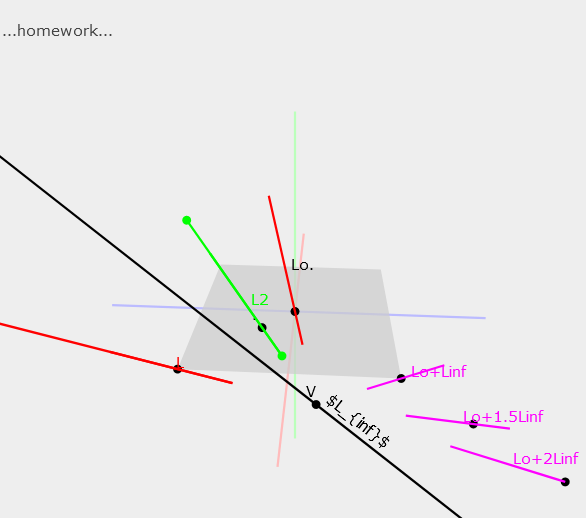Thank you, that is very helpful.
I am right to say that when L is obtained from L=a L_o + b L_\infty, then all L’s(pink lines) are part of the same line pencil (located on plane: L_o ^ L_\infty) , but if we translate L_o to L, the way shown below (red lines), then L becomes part of another line pencil? I still struggle on the way to translate L_o to the exact same L with a rotation (L2 green).
//++++++++++++++++++++++++++++++++++++++++++++++++++++++++++++
var a23=1, //u direction through the origine
a31=1, //v
a12=0 //w
//++++++++++++++++++++++++++++++++++++++++++++++++++++++++++++
var V = a231e032+a311e013+a12*1e021 // The ideal point of Lo
//++++++++++++++++++++++++++++++++++++++++++++++++++++++++++++
//++++++++++++++++++++++++++++++++++++++++++++++++++++++++++++
var Lo = (1e123 & V) // Line: Pt & dir
//++++++++++++++++++++++++++++++++++++++++++++++++++++++++++++
//++++++++++++++++++++++++++++++++++++++++++++++++++++++++++++
var sqrt = motor => (Math.sign(motor.s) + motor).Normalized;
var motor = (line,angle_or_distance)=>Math.E**(angle_or_distance/2 * line);
//++++++++++++++++++++++++++++++++++++++++++++++++++++++++++++
//++++++++++++++++++++++++++++++++++++++++++++++++++++++++++++
var here = point(1,0,1)
var Trans = ()=>sqrt(1e123 * here)
var Rotat = motor(Lo,here/2) //----------<<<<<--------------
var L = ~Trans * Lo * Trans
var L2 = ~Rotat * Lo * Rotat
//++++++++++++++++++++++++++++++++++++++++++++++++++++++++++++
